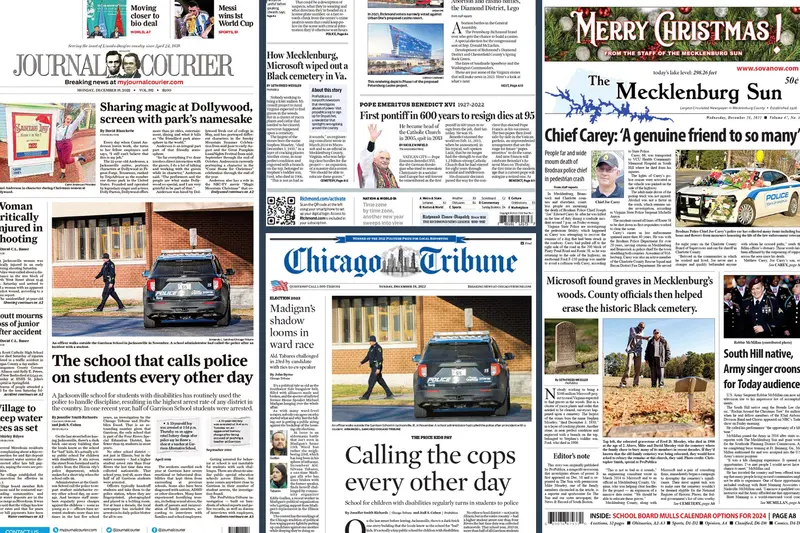Some Known Details About News Articles
Some Known Details About News Articles
Blog Article
Some Known Details About News Articles
Table of ContentsThe News Articles DiariesThe Best Strategy To Use For News ArticlesThe Basic Principles Of News Articles A Biased View of News ArticlesNews Articles Can Be Fun For Anyone
Great understanding of different topics gives pupils an one-upmanship over their peers. Despite the fact that electronic and social media sites are easily easily accessible, we must not forget exactly how important it is to review the newspapers. Moms and dads should attempt and inculcate the practice of reading a newspaper as a day-to-day routine to continue the legacy of the adored print tool.Information stories additionally include at the very least one of the complying with vital attributes loved one to the designated audience: closeness, prominence, timeliness, human rate of interest, oddity, or consequence.
Within these limitations, information stories additionally aim to be comprehensive. However, various other variables are entailed, some stylistic and some originated from the media kind. Among the larger and more recognized papers, justness and balance is a major consider presenting information. Commentary is usually confined to a separate section, though each paper might have a different overall angle.
Newspapers with a global audience, for example, often tend to utilize a more official design of composing. News Articles.; common design guides consist of the and the US Information Style Publication.
Get This Report on News Articles
Generally, journalists will not utilize a lengthy word when a short one will do. They utilize subject-verb-object building and dazzling, active prose (see Grammar). They supply anecdotes, examples and metaphors, and they rarely rely on generalizations or abstract ideas. News writers try to prevent utilizing the exact same word greater than as soon as in a paragraph (often called an "resemble" or "word mirror").
Headings in some cases omit the topic (e.g., "Leaps From Boat, Catches in Wheel") or verb (e.g., "Feline lady lucky"). A subhead (also subhed, sub-headline, subheading, subtitle, deck or dek) can be either a subservient title under the major headline, or the heading of a subsection of the write-up. It is a heading that comes before the primary text, or a group of paragraphs of the major message.

Added signboards of any of these kinds may click show up later on in the short article (especially on succeeding pages) to entice further analysis. read here Such billboards are additionally used as guidelines to the short article in various other sections of the magazine or site, or as ads for the item in other magazine or sites. Regular structure with title, lead paragraph (summary in vibrant), other paragraphs (information) and contact details.

Instance of a hard-lead paragraph NASA is recommending one more space project. The agency's budget demand, revealed today, consisted of a plan to send out another objective to the Moon. This moment the company wants to establish a long-term center as a jumping-off point for various other room journeys. The spending plan requests roughly $10 billion for the project.
The NASA announcement came as the agency asked for $10 billion of appropriations for the job. An "off-lead" is the second essential front page information of the day. The off-lead appears either in the leading left edge, or directly listed below the lead on the. To "hide the lead" is to begin the short article with history info or details of secondary relevance to the visitors, forcing them to review more deeply into an article than they must have to in order to uncover the essential points.
The 30-Second Trick For News Articles
Usual usage is that one or more sentences each form their very own paragraph. Reporters generally describe the organization or structure of a newspaper article as an inverted pyramid. The essential and most fascinating elements of a story are put at the beginning, with sustaining details following in order of decreasing importance.
It permits people to discover a subject to only the depth that their curiosity takes them, and without the charge of details or subtleties that they might think about unnecessary, however still making that information readily available to extra interested readers. The upside down pyramid structure also allows articles to be cut to any arbitrary size during format, to fit in the space offered.
Some writers begin their stories with the "1-2-3 lead", yet there are several kinds of lead available. A kicker can refer to numerous things: The last tale in the information broadcast; a "satisfied" story to end the program.
Longer articles, such as why not look here publication cover articles and the items that lead the inside sections of a paper, are referred to as. Function stories vary from straight information in a number of means. Foremost is the lack of a straight-news lead, many of the time. Rather than offering the essence of a tale in advance, feature writers may attempt to tempt viewers in.
The News Articles Ideas
A function's initial paragraphs commonly relate a fascinating moment or occasion, as in an "anecdotal lead". From the details of an individual or episode, its sight quickly broadens to generalities concerning the story's subject.

The Editor's Toolbox: A Reference Overview for Beginners and Professionals (2001) Allan M. Siegal and William G. Connolly. The New York Times Handbook of Style and Usage: The Authorities Style Guide Utilized by the Writers and Editors of the World's Many Reliable Paper (2002) M. L. Stein, Susan Paterno, and R.
Report this page